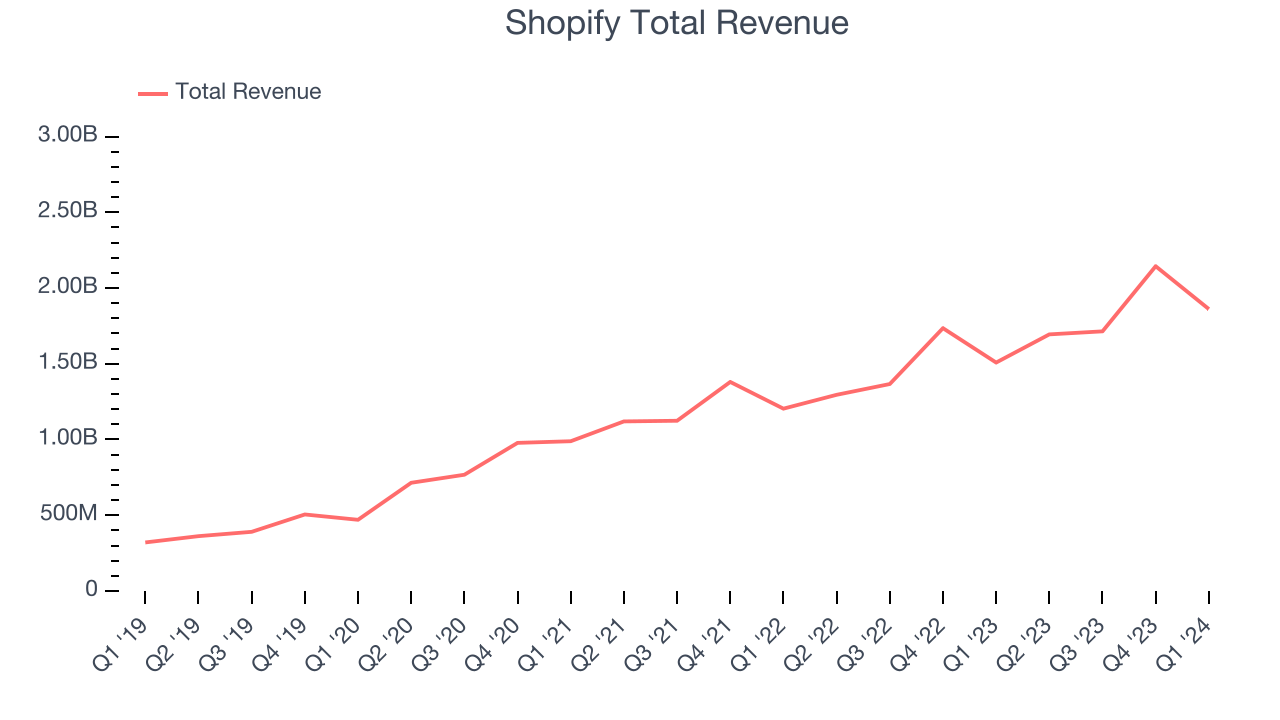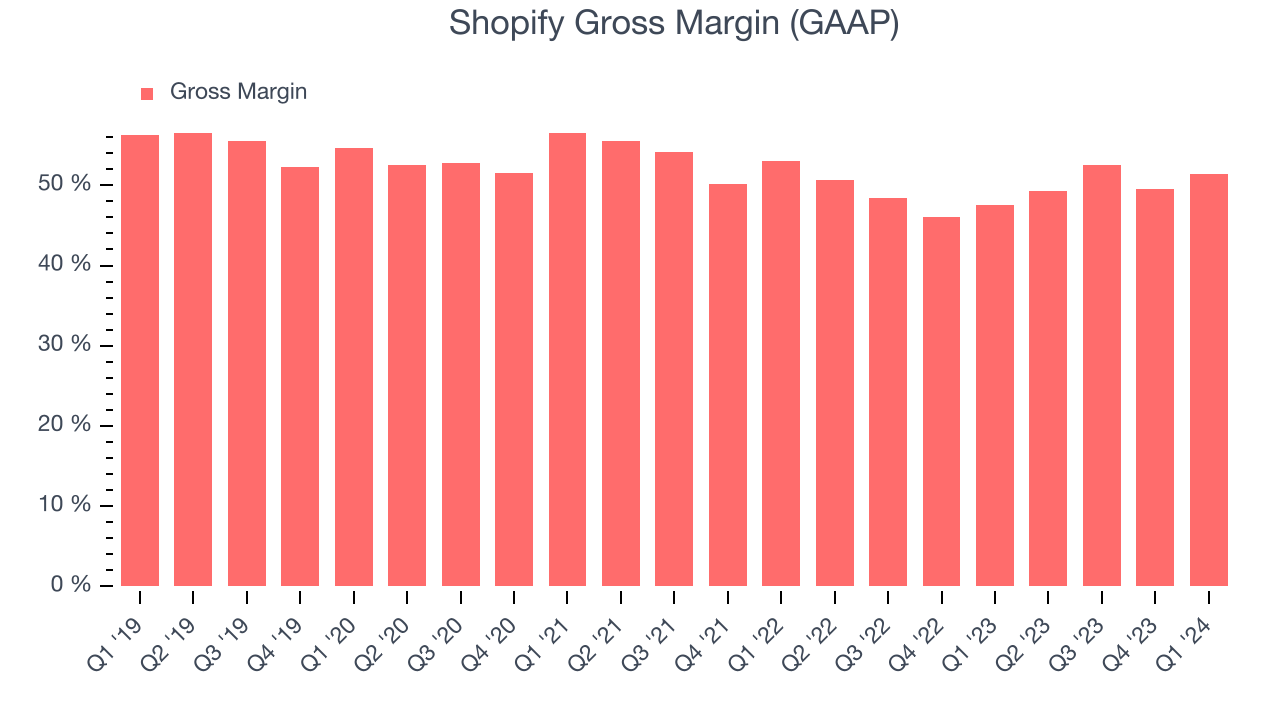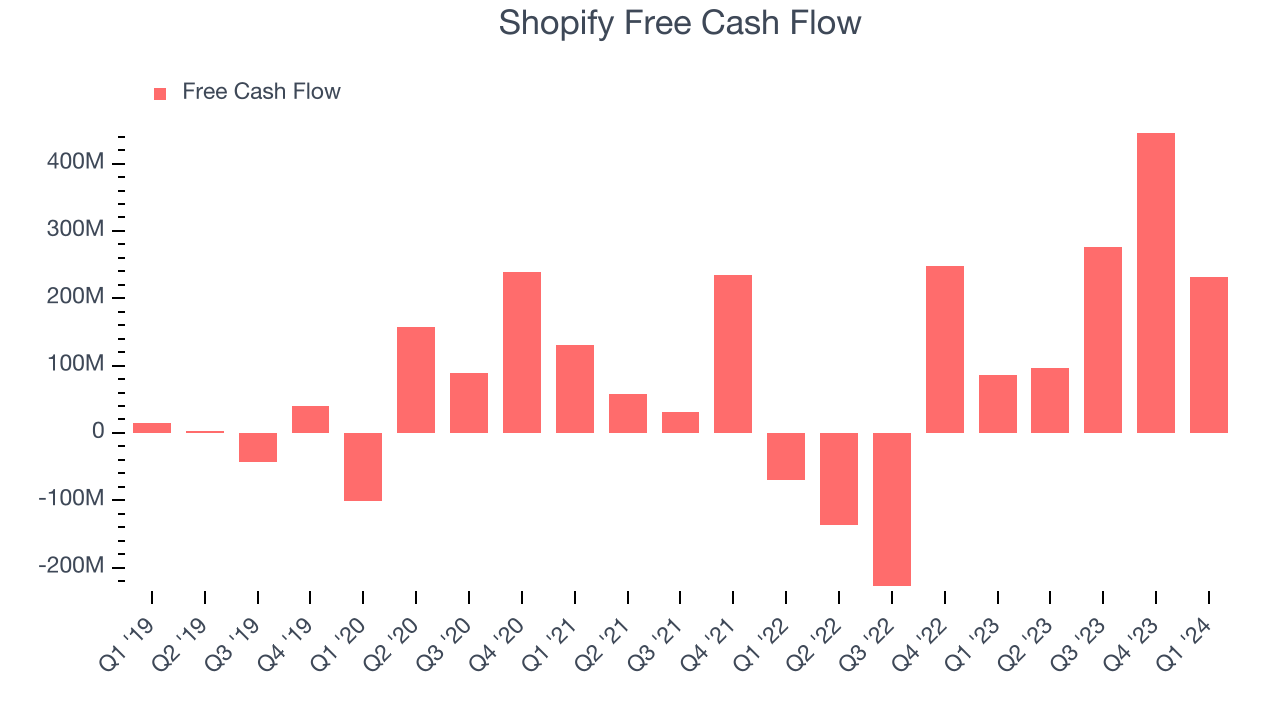E-commerce software platform Shopify (NYSE:SHOP) reported results in line with analysts' expectations in Q1 CY2024, with revenue up 23.4% year on year to $1.86 billion. It made a non-GAAP profit of $0.20 per share, improving from its profit of $0.01 per share in the same quarter last year.
Shopify (SHOP) Q1 CY2024 Highlights:
- Revenue: $1.86 billion vs analyst estimates of $1.85 billion (small beat)
- EPS (non-GAAP): $0.20 vs analyst estimates of $0.17 (17.9% beat)
- Gross Margin (GAAP): 51.4%, up from 47.5% in the same quarter last year
- Free Cash Flow of $232 million, down 48% from the previous quarter
- Market Capitalization: $99.27 billion
Originally created as an internal tool for a snowboarding company, Shopify (NYSE:SHOP) provides a software platform for building and operating e-commerce businesses.
Creating an e-commerce business is a very technical and complex process that serves as a high barrier to entry for many entrepreneurs.
Before selling a product online a business needs to have a functioning website, a payment processing system, inventory management, and a fulfillment process at the bare minimum. Because of the high technical barriers to starting an online business, many e-commerce companies could not function without a third-party platform that handles everything for them. Shopify’s cloud-based software aims to provide everything a business needs to sell online so that founders can focus on making products their customers love.
Many different types of online businesses trust Shopify to handle the digital infrastructure crucial for their operations. From solo entrepreneurs paying as little as $5 per month up to large enterprises with much more lucrative contracts, Shopify provides the necessary tools to start, grow, market, and manage an online retail business.
Shopify has expanded its services as it's grown and now includes services such as credit, where it can underwrite merchants better than traditional banks because it has granular transaction data on their businesses. The company has also built an app store where developers can create tools for the Shopify ecosystem.
E-commerce Software
While e-commerce has been around for over two decades and enjoyed meaningful growth, its overall penetration of retail still remains low. Only around $1 in every $5 spent on retail purchases comes from digital orders, leaving over 80% of the retail market still ripe for online disruption. It is these large swathes of the retail where e-commerce has not yet taken hold that drives the demand for various e-commerce software solutions.
Other providers of e-commerce software include: BigCommerce (NASDAQ:BIGC), GoDaddy (NYSE:GDDY), and Squarespace (NYSE:SQSP)Sales Growth
As you can see below, Shopify's revenue growth has been strong over the last three years, growing from $988.6 million in Q1 2021 to $1.86 billion this quarter.

This quarter, Shopify's quarterly revenue was once again up a very solid 23.4% year on year. However, the company's revenue actually decreased by $283 million in Q1 compared to the $430 million increase in Q4 CY2023. This situation is worth monitoring as Shopify's sales have historically followed a seasonal pattern but management is guiding for a further revenue drop in the next quarter.
Looking ahead, analysts covering the company were expecting sales to grow 21% over the next 12 months before the earnings results announcement.
Profitability
What makes the software as a service business so attractive is that once the software is developed, it typically shouldn't cost much to provide it as an ongoing service to customers. Shopify's gross profit margin, an important metric measuring how much money there's left after paying for servers, licenses, technical support, and other necessary running expenses, was 51.4% in Q1.

That means that for every $1 in revenue the company had $0.51 left to spend on developing new products, sales and marketing, and general administrative overhead. While its gross margin has improved significantly since the previous quarter, Shopify's gross margin is still poor for a SaaS business. It's vital that the company continues to improve this key metric.
Cash Is King
If you've followed StockStory for a while, you know that we emphasize free cash flow. Why, you ask? We believe that in the end, cash is king, and you can't use accounting profits to pay the bills. Shopify's free cash flow came in at $232 million in Q1, up 170% year on year.

Shopify has generated $1.05 billion in free cash flow over the last 12 months, a decent 14.2% of revenue. This FCF margin stems from its asset-lite business model and gives it a decent amount of cash to reinvest in its business.
Key Takeaways from Shopify's Q1 Results
We enjoyed seeing Shopify materially improve its gross margin this quarter. Overall, this quarter's results seemed fairly positive and shareholders should feel optimistic. Investors were likely expecting more, however, and the stock is down 16.7% after reporting, trading at $64.2 per share.
Is Now The Time?
When considering an investment in Shopify, investors should take into account its valuation and business qualities as well as what's happened in the latest quarter.
We think Shopify is a solid business. We'd expect growth rates to moderate from here, but its revenue growth has been strong over the last three years. And while its gross margins show its business model is much less lucrative than the best software businesses, the good news is its efficient customer acquisition hints at the potential for strong profitability. On top of that, its customers are increasing their spending quite quickly, suggesting they love the product.
Shopify's price-to-sales ratio of 11.1x based on the next 12 months indicates the market is certainly optimistic about its growth prospects. There are definitely things to like about Shopify, and there's no doubt it's a bit of a market darling, at least for some. But when comparing the company against the broader tech landscape, it seems there's a lot of good news already priced in.
Wall Street analysts covering the company had a one-year price target of $76.59 right before these results (compared to the current share price of $64.20).
To get the best start with StockStory, check out our most recent Stock picks, and then sign up for our earnings alerts by adding companies to your watchlist here. We typically have the quarterly earnings results analyzed within seconds of the data being released. Especially for companies reporting pre-market, this often gives investors the chance to react to the results before everyone else has fully absorbed the information.
